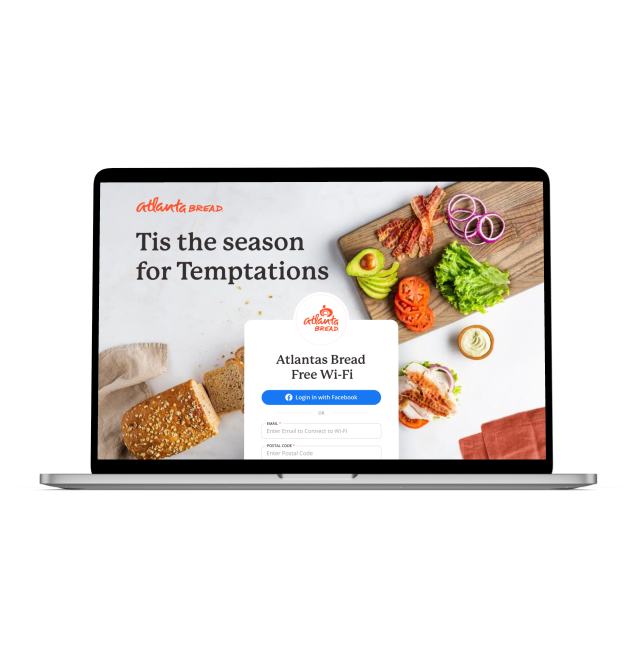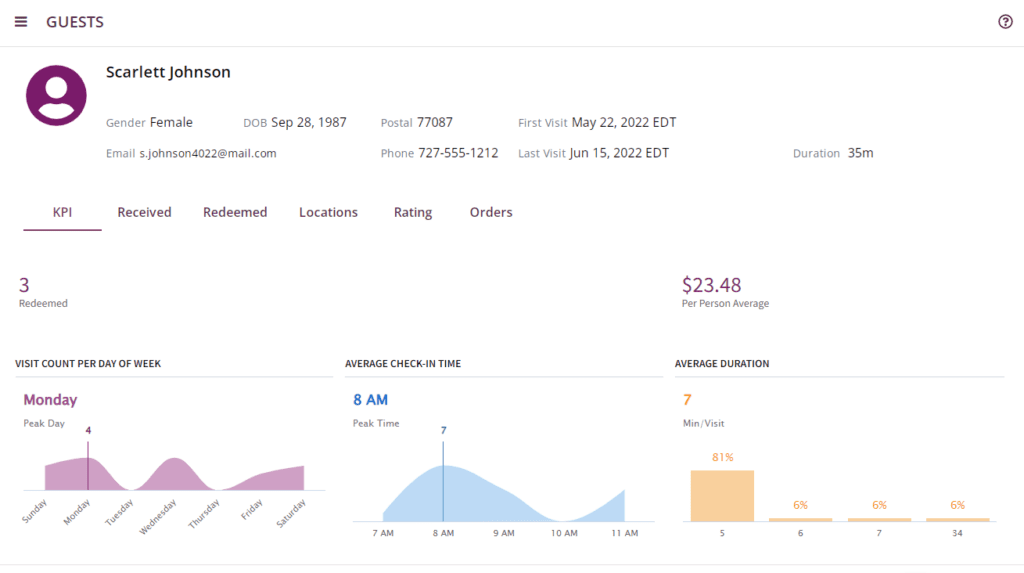WiFi Marketing in 2024: What Is It?
WiFi Marketing Measures Guest Behavior, Builds Your CDP Faster, and Automates Marketing.
- Identify and Win Back Lost Guests
- Send Guest Surveys
- Increase Guest Frequency

Scroll to explore
What Is WiFi Marketing in 2024?
Learn how WiFi Marketing uses guest WiFi to measure guest behavior, build your CDP when guests opt into WiFi, and automate marketing campaigns.
There are five top-level components of an effective smart WiFi marketing platform in 2024. These components consist of the following:
- WiFi Analytics
- Building Your Customer Database (CDP)
- Segmentation
- WiFi Marketing Campaigns
- WiFi Marketing Attribution
We discuss each of these pieces of the WiFi marketing puzzle below.
It is important to fully understand each piece of the puzzle to get a complete understanding of WiFi marketing when you’re looking to choose the right WiFi marketing platform for your business.
Quick Links:
1. Understanding WiFi Marketing

Every mobile device has a unique identifying code. If a mobile device has WiFi enabled, it is constantly sending out a signal seeking out a WiFi access point.
This signal includes the device’s unique code and is how a WiFi marketing platform identifies individual guests, whether the user logs into the WiFi or not.
When a mobile device enters the range of the access point, the signal is detected and analyzed to understand anonymous guest behavior at your locations.
Once a guest opts into the guest WiFi, WiFi marketing solutions will collect names, emails, phone numbers, birthdays, zip codes, phone numbers, and guest behavior into detailed customer profiles in your CDP or customer database.
WiFi marketing platforms trigger marketing based on a guest’s behavior or lack of behavior at a physical location. It also tracks all marketing campaigns down to a guest walking back into your location.
Below we will go into more detail about what makes up an enterprise WiFi marketing platform.
2. WiFi Analytics
WiFi Analytics involves the process of collecting & analyzing anonymous guest data from WiFi access points, whether the guest logs into the WiFi or not.
This process allows physical locations to understand guest behavior, such as customer traffic patterns, dwell times, first-time visitors, and the likelihood of a guest churning or not coming back.
Restaurant operators use WiFi analytics to improve operations by unlocking guest insights, triggering marketing, and allowing operators to track the performance of marketing campaigns down to a person walking back in a location’s doors.
3. Building a Customer Data Platform or Customer Database
When a guest opts into your WiFi landing page, WiFi marketing platforms start building detailed customer profiles automatically in your customer data platform (CDP) that provides a single customer view (SCV) of your customers.
Legacy WiFi marketing platforms only allow you to collect guest data from one source – your guest WiFi – to build a CRM database.
Bloom Intelligence, however, allows you to collect guest data from multiple sources that include your guest’s WiFi, online ordering platforms, reservation systems, point of sales, your website, social media, and review sites to include in your customer data platform.
A customer data platform is more advanced than a normal CRM database because it allows businesses to combine guest data and behavior from multiple sources of guest data to create a centralized customer database.
This allows operators to gain a single customer view (SCV) based on your guest’s data and behavior across all platforms that your guest interacts with for your business.
Bloom Intelligence guest profiles include:
- Name
- Email address
- Gender
- Birthday
- Phone number
- Zip code
- Behavior
- Likelihood to churn
- Ratings received
- Offers received
- Orders

Additionally, all behavior data, such as visit information, physical locations visited, online orders, PPA (per person average), offers received/redeemed, and ratings/reviews received, are easily accessed from each customer profile.
Bloom cleans and verifies all data in real time.
According to Data Services, Inc., on average, 65% of contact data generated from online forms is invalid. But with Bloom, when guests opt-in, they will not be able to pass fake emails, phone numbers, or birthdays.
This process of cleaning all incoming guest data allows you to have a proper understanding of your guests and gives you the ability to market to your first-party customer database confidently.
An advanced option that Bloom provides is the ability to use progressive profiling.
Progressive profiling is when users come for a repeat visit online or at your location. The Bloom platform will ask a guest for an additional piece of information that is missing from their profile every time they interact with your WiFi landing page, website form, or online ordering platform.
This helps to ensure that you are building complete guest profiles that can be used to make better decisions and build personalized guest experiences, ultimately creating guest loyalty and a larger guest lifetime value.
According to Forbes, there is a whopping 80% increase in revenue for businesses focusing on improving customer experience.
4. Segmentation
Bloom customers quickly grow their customer data platforms to thousands or millions of guest profiles by aggregating guest data from their WiFi, POS, website, social media, and online ordering platforms into their Bloom CDP.
Since each consumer profile contains, at a minimum, a guest’s contact information (such as an email address) and behavior at your location and online ordering, they now have a list of actual guests to market to for the life of a person having that email address.
Building a CDP allows restaurants to use segmentation to quickly and easily take your list of contacts and segment them into smaller, more targeted groups.
Segmentation is the process of dividing your guests into groups or lists with similar behavior, demographics, and needs.
For instance, you can segment your list into males or females. You can create a separate list of guests above or below a specific age.
You can create a list of users who fall under a specified dwell time or visit count, for instance. Or, you can create a list of guests who have ordered online at least x times.
The options are endless since you can add these multi-variant filters to any list.
What Can You Do With Your Lists?
This type of segmentation allows restaurants to understand their guests better, create personalized marketing campaigns, and improve guest experiences.
A survey from Mailchimp found that segmented, personalized campaigns had open rates 14.31% higher than non-segmented campaigns. They also saw a whopping 101% increase in clicks while noting lower bounce rates, unsubscribes, and spam reports.
Segmentation and personalization improve guest loyalty and trust in your brand, leading to more guests and higher customer lifetime values.
The idea is that not all of your guests will be highly engaged with the same type of message.
Women over 40 on Mother’s Day will engage more with a warm, emotional greeting than Gen-Z men who come on Sundays to watch football.
Therefore, guest segmentation allows you to send a different message to various guest groups.
You can save these lists as smart lists that automatically update with any guest who meets the criteria of the lists or remove guests who no longer meet the criteria of the lists and any marketing campaigns that these lists are associated too.
Or, you can save each segment as a static list which is a snapshot in time and will never change.
Once you associate these lists with their specific marketing campaigns and messages, this process creates true marketing automation for your multi-unit restaurant or retail locations.
When you personalize your guest’s experience, engagement rates will climb. As a result, customer loyalty will also increase as marketing costs decline, leading to a healthier bottom line.
5. WiFi Marketing Automation
Once all of this guest data is added to your customer data platform in real time, you can begin experiencing the actual value of WiFi Marketing.
With these new guest insights, you’ll begin to understand who your guests are and how they behave both online and offline.
You’ll understand how your guest behaves in your restaurant, online, and across other channels.

Smart WiFi marketing allows you to trigger specific marketing campaigns based on your guest’s behavior or lack of behavior at your restaurant.
WiFi marketing campaigns can email or text bounce-back offers, survey requests, and call to action.
Save Time and Increase Revenue with WiFi Marketing Automation
Messages, offers, or surveys can be sent immediately, at a future date and time, on a recurring schedule, or when a guest meets specific behavioral criteria (triggered).
Triggered messages can be sent based on the following:
- Milestone – when guests reach predetermined milestones such as their 10th, 25th, or 100th visit.
- Loyalty – every time a guest reaches a predetermined number of visits.
- Rating – when a guest provides a rating at or below a level you specify.
- Anniversary – when guests reach the anniversary of their first visit.
- Birthday – a configured number of days before a guest’s birthday.
- Upon Exit – a predetermined number of days or hours after a person leaves a location.
- Upon Registration – shortly after a guest first registers (logs in) on your WiFi, makes an online order or fills out a website form.
- At-Risk of Churning – when a guest has been determined as unlikely to return by our statistical model.
- At-Risk (number of days) – when a guest has not returned after a set number of days.
- Upon Order – a predetermined number of days or hours after a person makes an online order.
6. WiFi Marketing Attribution
Marketing attribution can be defined as quantifying the influence that each of your marketing campaigns or strategies has on a guest’s decision to visit your restaurant, come back again, order online, complete a survey, or leave an online review.
For instance, if you execute an automated WiFi marketing campaign to get guests to complete a survey, then every survey that any of those guests complete can be attributed to that specific campaign.
With a restaurant customer data platform, which gathers behavior data from multiple channels, attribution can be given very quickly because it allows you to measure actual guest behavior.
For example, with WiFi marketing attribution, you’ll be able to see if a guest visited your restaurant, made an online order, left an online review on sites like Google or Facebook, completed a survey, increased their dwell time or PPA, or other desired behavior.
This gives you an accurate picture of how well your campaign is performing.
Attribution can not only tell you how your campaigns are performing, but it can also help make them even better.
Over time, savvy restaurateurs will change their messaging to improve engagement with the messages – more opens, clicks, and conversions.
With detailed attribution, it is easy to identify whether a change improved the campaign performance or if performance declined.
Then, you can make intelligent, data-driven decisions to optimize your messaging and strategies over time.
WiFi marketing attribution is key to monitoring, testing, and optimizing your restaurant marketing campaigns. It will give your restaurant a valuable competitive advantage because you will know what is and is not working based on actual guest engagement.
7. WiFi Marketing: Gaining The Upper Hand
Bloom’s restaurant WiFi marketing and customer data platform can automate the aggregation of accurate, real-time data on your actual customer base (first-party data) while being privacy compliant.
This means one thing – no more guessing!
You can confidently create highly-targeted marketing campaigns that you can measure precisely, allowing for robust and profitable marketing efforts.
You’ll be able to measure results and optimize your campaigns over time accurately.
If they do not perform as well as expected, you can easily adjust your tactics and messaging and watch the results in real time.
We hope we have answered your question, “What is WiFi Marketing?” If you have any questions, feel free to contact us.
It’s time to start using real-time, in-store WiFi marketing and restaurant analytics to uncover hidden marketing opportunities that power successful restaurants.
With the ability to see detailed attribution and ROI of every campaign, Bloom delivers the most complete and powerful WiFi marketing solution and analytics suite of tools available today.
Contact Bloom Intelligence Today For a Free Demo!
- Call 727-877-8181
- Email us at sales@bloomintelligence.com
- Schedule a Demo
The Power of WiFi Marketing

Optimize retail &
business operations

Track attribution of
guest campaigns

Trigger marketing
campaigns based on
marketing presence

Measure the health
of corporate & franchisee
locations

Compare locations or
group of locations to
quickly identify opportunities
or threats
Are you ready to grow
Your business with
WiFi marketing?
If so, find out how Bloom Intelligence’s WiFi analytics
& WiFi marketing platform measures offline guest
behavior and builds guest loyalty.
It’s time to start leveraging your guest WiFi to gain
a competitive edge. Then watch your profits grow.






